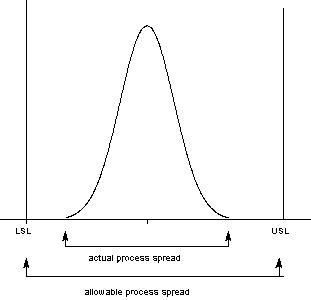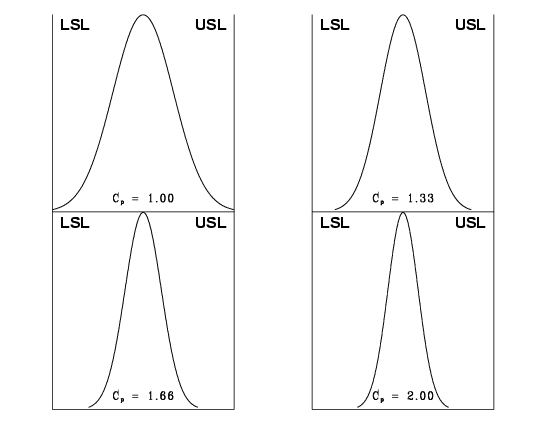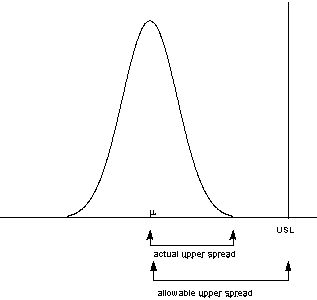6.
Process or Product Monitoring and Control
6.1.
Introduction
6.1.6.
|
What is Process Capability?
|
|
|
|
Process capability compares the output of an in-control process
to the specification limits by using capability indices. The
comparison is made by forming the ratio of the spread between the
process specifications (the specification "width") to the spread of
the process values, as measured by 6 process standard deviation units
(the process "width").
Process Capability Indices
|
|
A process capability index uses both the process variability and
the process specifications to determine whether the process is
"capable"
|
We are often required to compare the output of a stable process with
the process specifications and make a statement about how well the process
meets specification. To do this we compare the natural variability
of a stable process with the process specification limits.
A process where almost all the measurements fall inside the
specification limits is a capable process.
This can be represented pictorially
by the plot below:

There are several statistics that can be used to measure the capability
of a process: , , and .
Most capability indices estimates are valid only if the sample size
used is "large enough". Large enough is generally thought to be about
50 independent data values.
The , , and
statistics assume that the population of data values is normally distributed.
Assuming a two-sided specification, if
and
are the mean and standard deviation, respectively, of the normal data and
, , and are the upper and lower
specification limits and the
target value, respectively, then the population capability indices are
defined as follows.
|
|
Definitions of various process capability indices
|
|
|
Sample estimates of capability indices
|
Sample estimators for these indices are given below.
(Estimators are indicated with a "hat" over them).
The estimator for
can also be expressed as ,
where
is a scaled distance between the midpoint of the specification range, ,
and the process mean, .
Denote the midpoint of the specification range by .
The distance between the process mean, ,
and the optimum, which is ,
is ,
where .
The scaled distance is
(The absolute sign takes care of the case when
).
To determine the estimated value, ,
we estimate
by .
Note that .
The estimator for the
index, adjusted by the
factor, is
Since ,
it follows that .
|
|
Plot showing
for varying process widths
|
To get an idea of the value of the
statistic for varying process widths, consider the following plot.

This can be expressed numerically by the table below:
|
|
Translating capability into "rejects"
|
|
|
|
|
|
|
|
|
1.00
|
1.33
|
1.66
|
2.00
|
|
Rejects
|
0.27 %
|
64 ppm
|
0.6 ppm
|
2 ppb
|
|
% of spec used
|
100
|
75
|
60
|
50
|
where ppm = parts per million and ppb = parts per billion. Note that
the reject figures are based on the assumption that the distribution is
centered at .
We have discussed the situation with two spec. limits, the and .
This is known as the bilateral or two-sided case. There are many
cases where only the lower or upper specifications are used. Using one
spec limit is called unilateral or one-sided. The corresponding
capability indices are
|
|
One-sided specifications and the corresponding capability indices
|
and
where
and
are the process mean and standard deviation, respectively.
Estimators of and
are obtained by replacing
and
by and ,
respectively. The following relationship holds
This can be represented pictorially by

Note that we also can write:
|
|
|
Confidence Limits For Capability Indices
|
|
Confidence intervals for indices
|
Assuming normally distributed process data, the distribution of the
sample
follows from a Chi-square distribution and
and
have distributions related to the non-central t distribution.
Fortunately, approximate confidence limits related to the normal
distribution have been derived. Various approximations to the
distribution of
have been proposed, including those given by
Bissell (1990), and we will use a normal approximation.
The resulting formulas for confidence limits are given below.
Confidence Limits for are
where
and degrees of freedom.
|
|
Confidence Intervals for and
|
Approximate %
confidence limits for
with sample size
are:
and
with
denoting the percent point function of the standard normal
distribution. If
is not known, set it to .
Limits for
are obtained by replacing
by .
|
|
Confidence Interval for
|
Zhang et al. (1990)
derived the exact variance for the estimator of
as well as an approximation for large .
The reference paper is Zhang, Stenback and Wardrop (1990),
"Interval Estimation of the process capability index," Communications
in Statistics: Theory and Methods, 19(21), 4455-4470.
The variance is obtained as follows.
Let
Then
Their approximation is given by:
where
The following approximation is commonly used in practice
It is important to note that the sample size should be at least 25 before
these approximations are valid. In general, however, we need
for capability studies. Another point to observe is that
variations are not negligible due to the randomness of capability
indices.
|
|
|
Capability Index Example
|
|
An example
|
For a certain process the and the . The observed
process average, ,
and the standard deviation, .
From this we obtain
This means that the process is capable as long as it is located
at the midpoint, .
But it doesn't, since .
The
factor is found by
and
We would like to have
at least 1.0, so this is not a good process. If possible, reduce the variability
or/and center the process. We can compute the
and using
and
From this we see that the ,
which is the smallest of the above indices, is 0.6667.
Note that the formula
is the algebraic equivalent of the
definition.
|
|
|
What happens if the process is not approximately normally
distributed?
|
|
What you can do with non-normal data
|
The indices that we considered thus far are based on normality of the
process distribution. This poses a problem when the process distribution
is not normal. Without going into the specifics, we can list some
remedies.
- Transform the data so that they become approximately normal. A
popular transformation is the
Box-Cox
transformation
- Use or develop another set of indices, that apply to nonnormal
distributions. Non-parameteric versions
(Pearn, Tai, Hsiao, and Ao
(2014) and
Chen and Ding (2001))
of the , , and capability indices
are denoted by , , and .
Estimators for these non-parameteric capability indices are
calculated by
where is the 99.865th percentile of the data
and is the 0.135th percentile of the data.
The use of these percentiles is justified to mimic the
coverage of ±3 standard deviations for the normal distribution.
Note that some sources may use 99% coverage. For example, the
statistic may be given as
where is the 99.5th percentile of the data
and is the 0.5th percentile of the data.
For additional information on nonnormal distributions, see
Johnson and Kotz
(1993).
There is, of course, much more that can be said about the case of
nonnormal data. However, if a Box-Cox transformation can be successfully
performed, one is encouraged to use it.
|




